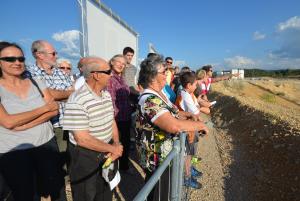Site visits pass the 80,000 mark
20 Mar 2015
-
Julie Marcillat, ITER Communication
The number of visitors to the ITER site increases steadily from year to year, testimony of the public's strong interest in the ITER Project. A total of 83,999 people have visited the site since 2008, 16,824 of them in 2014 (a 13.5 percent increase over 2013).
Visits are key to increasing public awareness about ITER and establishing good relations with the surrounding community, institutions, industries and schools. Visits are organized by the ITER Organization visit team in close collaboration with Agence Iter France—the ITER team manages visits for the general public, companies, international delegations, politicians and the media, while Agence ITER France runs a dedicated program for school groups.
In 2014, 42 percent of all visitors were school children (just over 7,000 young visitors). Another 30 percent came from the "general public" (nearly 5,000 people), 15 percent from industry, 6 percent from universities, and the remainder (7 percent) from government and international institutions, the media, or ITER Domestic Agencies.
Approximately one out of every six visits was "technical"—visitors with specialized interests who benefitted from presentations and a site tour led by ITER staff from the technical divisions (buildings and construction, electrical, plasma science, etc.).
But ITER scientists and engineers also appreciate the chance to exchange with the general public. For Joël Hourtoule, Electrical Power Distribution Section leader, "visits are the link between the engineers contributing to the project and the public. For an engineer, it is important to be able to explain what kind of works we are doing here and to get feedback from the public. It's always a good experience to meet the outside world and to answer the many questions they may have."
Visits also take place as part of technical working groups, that convene to work on specific issues. In that context, ''visits are a way to share experiences with technical staff from other industries. We share our experience, for example, in conception requirements and construction techniques within the framework of a nuclear facility,'' says Laurent Patisson, head of the Nuclear Buildings Section.
Interest remains high from university-level students studying fusion technology and engineering all around the world. "Giving talks to university students is the perfect way to show them what comes after they have completed their studies, and how to put theory into practice," says Laurent. Tom Farley, a PhD student in physics and an intern currently at CEA Cadarache, agrees: "It's a great chance that ITER is open to the public. For students like me, catching a glimpse of this challenging project and meeting the staff working here is a unique opportunity to see what is happening behind the scenes. It gives me hope for the future and—who knows—I might apply for a position in the years to come!"


